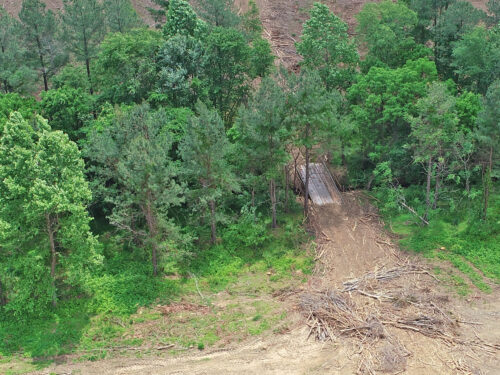
The implementation of forestry best management practices (BMPs) to protect water quality in Virginia on a timber harvest occurs during the course of the timber harvest. It begins with proper harvest planning to minimize the impact of the harvest on the site and any water associated with the site. BMPs are implemented during the course of the timber harvest and upon completion to keep sediment movement on site to a minimum with the ultimate goal of keeping sediment associated with the timber harvest from moving to a watercourse.
This program focuses cost-share funding provided by the Commonwealth of Virginia’s Water Quality Improvement Fund to those areas of a timber harvest that can potentially deliver sediment to a stream. This would encompass stream crossings, associated road or trail approaches, structures associated with the stream crossing (portable bridges or culverts), equipment time and other soil stabilizing supplies (seed, mulch, etc.) needed to close out the crossing.
The program is designed to assist the logger with off-setting some of the costs associated with the installation of a proper stream crossing that minimizes the impact of sediment delivery to a stream channel that must be crossed to access timber.
Who is Eligible
- Logging contractors who have maintained their training under Virginia’s SHARP Logger Program administered by Virginia Tech Cooperative Extension and supported by the Virginia Forestry Association and the Sustainable Forestry Infinitive State Implementation Committee.
- Logging contractors who do not have any outstanding debt to the Department of Forestry.
- Logging contractors who do not have any unresolved water quality actions under the Silvicultural Water Quality Law.
What is Covered
The cost share covers the purchase of supplies, labor for the stream crossing installation, and any equipment time associated with the installation and closeout.
Upon completion of the project, all receipts for supplies will be submitted along with a statement of any equipment time and labor used on the project to the water quality staff person that developed the plan.
Cost-Share Amount
The rate of cost share is 75% of the actual cost of the items up to $6,000 for the installation of best management practices associated with the stream crossing. If the project includes the purchase of a portable bridge to cross the stream, then the maximum amount increases to $12,000 (75% up to $12,000 if a portable bridge is part of the project).
To Apply
To apply, contact one of the VDOF water quality staff for your area. They will inspect the stream crossing that you would like cost-share assistance for and help develop a plan for the crossing and closeout upon completion. They will help complete the application, Form 18.11 Logger BMP Cost-Share Application, which will be submitted to the water quality program manager at the VDOF Headquarters for approval. Once approved, the work may commence.
Apply by contacting your local water quality specialist or engineer.
Additional Resources
[posts_table columns="image,title:Title,cf:id_number:ID,content:Description,tax:Media,button" post_type="document-library" rows_per_page="5" exclude_term="Audiences:no, Media:news-releases" term="document-tags:logger-bmp-program" filters="tax:document-category:Select Category,tax:Media:Select Content Type" search_box="true" reset_button="true"]A variety of financial assistance programs are available through VDOF and partner agencies for forest management activities to protect water quality.
Explore All Financial Assistance Programs
Contact Us
Your local VDOF water quality staff can assist you with applying for this cost-share program. Contact your local VDOF staff.
For more information or questions, e-mail us or use our contact form.
